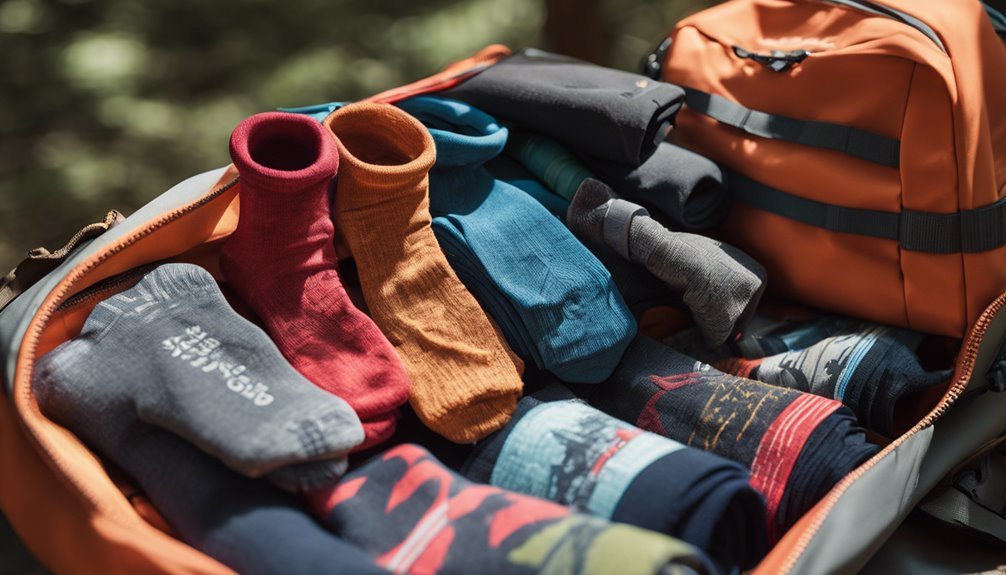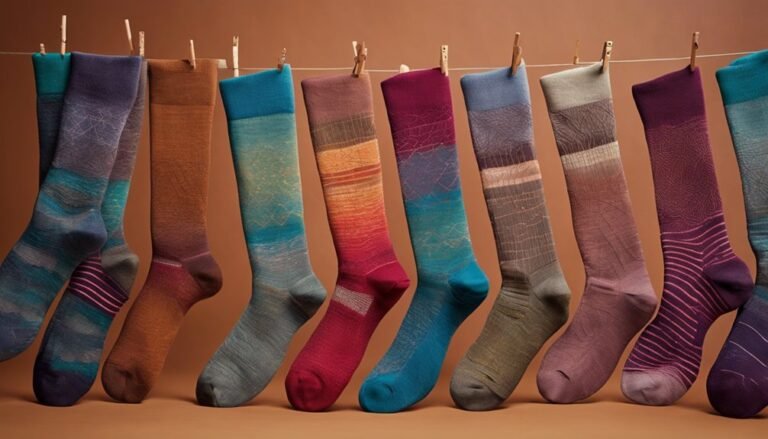How to Pack Socks Efficiently for Backpacking Trips
To pack socks efficiently for backpacking trips, roll them to save space and minimize wrinkles, or fold them for organization. Use compression bags for additional space-saving and easy access. Tuck socks inside your shoes or gear compartments to optimize storage and prevent clutter. Keep them dry by checking for moisture and using breathable bags. Remember to pick the right socks based on planned activities and climate. There's more to explore about keeping your backpack organized and your socks fresh.
Choosing the Right Socks for Your Trip

When you're gearing up for a backpacking trip, choosing the right socks can make all the difference in your comfort on the trail. Start by considering sock materials; merino wool is a popular choice for its moisture-wicking properties and temperature regulation. Synthetic blends can also work well, providing durability and quick-drying capabilities. Next, think about sock thickness. Thicker socks offer extra cushioning but can lead to overheating in warm weather, while thinner socks can be cooler but may not provide enough support for long hikes. Ultimately, you want a balance that suits the terrain and climate. Remember, the right sock can help prevent blisters and keep your feet feeling fresh, allowing you to focus on the freedom of the open trail.
Rolling vs. Folding: The Best Packing Methods
Packing your socks efficiently can enhance your backpacking experience, especially after you've chosen the right pairs for your adventure. When it comes to socks organization, you've got two main packing strategies: rolling and folding. Rolling socks can save space and allow you to fit them into tight spots in your backpack, while also minimizing wrinkles. On the other hand, folding socks neatly can help keep them organized and easy to access, preventing them from getting lost in your gear. If you prefer quick access and less clutter, rolling might be your best bet. If you value neatness, opt for folding. Ultimately, choosing the method that fits your style will make your backpacking journey more enjoyable and hassle-free.
Utilizing Compression Bags for Sock Storage
Using compression bags for sock storage can save you valuable space in your backpack. Not only do they help keep your socks organized, but they also protect them from moisture and dirt. Let's explore some effective packing techniques to maximize efficiency with these handy bags.
Benefits of Compression Bags
Although you might not think about it, utilizing compression bags for sock storage can considerably enhance your backpacking experience. These bags offer significant compression benefits, allowing you to minimize the space your socks occupy. This packing efficiency means you can fit more essentials into your backpack without sacrificing comfort. By keeping your socks organized, you'll also save time during your trips, making it easier to grab what you need on the go. Compression bags are lightweight and versatile, ensuring you won't add extra weight to your pack. Plus, they help protect your socks from moisture and dirt, keeping them fresh for those long hikes. Embrace the freedom that comes with smarter packing solutions!
Packing Techniques for Efficiency
Five effective packing techniques can maximize efficiency when utilizing compression bags for sock storage. First, roll your socks tightly to reduce bulk—this method not only saves space but also keeps them organized. Second, categorize your socks by type or purpose, making it easier to find what you need on the go. Third, use the compression feature of your bags wisely; don't overpack to maintain their effectiveness. Fourth, consider using smaller bags for different sock types, which allows for quick access during your trips. Finally, always leave a little extra room in your backpack for unexpected items. By implementing these packing strategies, you'll enjoy a more streamlined and efficient backpacking experience, giving you the freedom to explore without the clutter.
Storing Socks Inside Other Gear
One effective way to maximize space in your backpack is by storing socks inside other gear. This simple trick can help you optimize sock storage while keeping your pack organized. You can tuck socks into shoes, water bottles, or any gear compartments that might otherwise go unused. Not only does this free up valuable space, but it also protects your socks from getting crumpled or lost. When you reach your campsite, you'll find your socks ready to wear without the hassle of rummaging through your entire pack. Plus, it adds a layer of cushioning for fragile items. So, take advantage of every nook and cranny in your gear, and embrace the freedom of a well-packed backpack!
Organizing by Weight and Type

After maximizing space by storing socks inside your gear, it's time to think about how to organize them in your backpack. Proper organization enhances weight distribution and makes it easier to find what you need. Consider using type categorization for efficiency. Here's a practical approach:
- Lightweight Socks: Pack these for warmer days or casual walks.
- Heavyweight Socks: Keep these for colder conditions or longer hikes.
- Compression Socks: Store these for recovery and circulation support.
- Specialty Socks: Organize any waterproof or cushioned pairs separately.
Keeping Socks Dry on the Trail
To keep your socks dry on the trail, start by choosing moisture-wicking materials that pull sweat away from your feet. This will help prevent that uncomfortable dampness that can lead to blisters. Additionally, using waterproof bags for storage guarantees your socks stay protected from unexpected rain or river crossings.
Choose Moisture-Wicking Materials
Choosing moisture-wicking materials for your socks is essential if you want to keep your feet dry and comfortable on the trail. Moisture management is key, as wet feet can lead to blisters and discomfort. By opting for the right fabric technology, you'll enjoy your adventure without worrying about soggy socks. Here are four materials to take into account:
- Merino Wool – Naturally moisture-wicking and odor-resistant.
- Synthetic Fabrics – Quick-drying and lightweight, ideal for hot conditions.
- Bamboo – Soft, breathable, and eco-friendly, offering great moisture control.
- Coolmax – Engineered for superior moisture management, keeping your feet cool.
Invest in quality socks that incorporate these materials, and you'll be ready to tackle any trail with confidence!
Use Waterproof Bags
Even with the best moisture-wicking socks, keeping your feet dry on the trail can be a challenge if you don't protect them from external moisture. Using waterproof bags is a smart move to guarantee your socks stay dry. Look for bags made from durable waterproof materials that can withstand the elements. When packing, consider using compression techniques to minimize space—this not only saves room in your backpack but also helps keep your socks from shifting around. By sealing your socks in waterproof bags, you create a barrier against rain or river crossings, allowing you to focus on enjoying your adventure without worrying about soggy feet. Stay dry, stay comfortable, and embrace the freedom of the trail!
Maximizing Space in Your Backpack
While you might think socks are just small items that can easily fit anywhere, packing them strategically can make a significant difference in maximizing space within your backpack. Effective space optimization and backpack organization are key to enjoying your adventures without unnecessary bulk. Here are some tips to help you:
- Roll Your Socks: Rolling saves space and helps prevent creasing.
- Stuff Inside Shoes: Utilize empty shoe space to tuck in your socks.
- Use Compression Bags: These help reduce volume and keep your socks organized.
- Layer Wisely: Place lighter socks on top of heavier ones for easy access.
Tips for Maintaining Sock Hygiene
To guarantee your feet stay comfortable and healthy on your backpacking journey, maintaining sock hygiene is essential. Start with regular sock washing—ideally after each hike—to remove sweat and bacteria. If you're short on water, try rinsing them in a stream to freshen them up. For effective odor control, consider using moisture-wicking socks made from synthetic materials; they help keep your feet dry and minimize smells. When you can't wash your socks, airing them out overnight can work wonders. Always pack an extra pair or two, so you have clean options ready when needed. Finally, remember to dry your socks completely before stowing them away, preventing mildew and ensuring a fresh start on your next adventure.
Frequently Asked Questions
How Many Pairs of Socks Should I Pack for a Week-Long Trip?
For a week-long trip, you should pack about five pairs of socks. Consider sock types: choose a mix of lightweight and thicker options for versatility. Smart sock packing guarantees comfort and keeps your feet happy on the journey.
Can I Use Cotton Socks for Backpacking?
You can use cotton socks for backpacking, but they're not ideal. They don't manage moisture well, which can lead to blisters and discomfort. Consider moisture-wicking socks for better performance and comfort on your adventures.
What Are the Best Materials for Hiking Socks?
When choosing hiking socks, consider wool vs. synthetic materials. Wool provides warmth and moisture-wicking, while synthetic offers quick-drying and durability. You'll appreciate how each material complements your adventure, ensuring comfort during every step you take.
Should I Bring Extra Socks for Wet Conditions?
Absolutely, you should bring extra socks for wet conditions. Moisture-wicking fabrics help keep your feet dry, and knowing sock drying techniques can save you discomfort on your adventures. You'll appreciate the freedom of dry, comfortable feet!
How Do I Prevent Blisters While Wearing Socks?
To prevent blisters, make certain your socks fit snugly without being too tight. Choose moisture-wicking materials for breathability, and consider double-layer socks for extra protection. Keep your feet dry, and you'll enjoy your adventures more!







